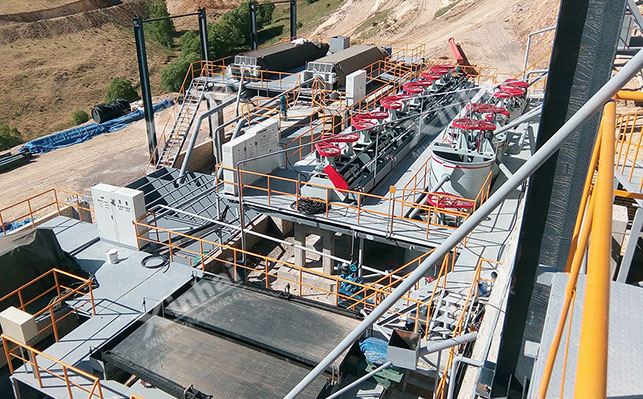The composition of pyrite is usually complex, and common associated minerals include cobalt, nickel, copper, gold, silver, lead, zinc, etc., and the distribution of particles is uneven. It is difficult to separate them from gangue minerals by relying on only one beneficiation process. Therefore, in the process of pyrite separation, combined beneficiation process is often used. This article introduces two common combined beneficiation process flows.

1.1 Flotation process
Flotation process can be said to be a very common method for pyrite beneficiation, which is suitable for processing fine-grained pyrite. In the beneficiation process, pyrite is separated from gangue minerals by adding flotation agents, which has the advantages of flexible operation, strong adaptability and high beneficiation recovery rate.
1.2 Gravity separation process
Gravity separation process is usually used to separate gangue minerals with a large density difference from pyrite. Common gravity separation methods include shaking table gravity separation and jigging gravity separation. The advantages of gravity separation process are low cost, low energy consumption, and simple and easy method.
1.3 Magnetic separation process
Magnetic separation process is used to treat magnetic impurities in pyrite. Although magnetic separation is efficient and environmentally friendly, its application range is extremely limited and can only be used to treat pyrite that does not contain magnetic impurities.
1.4 Chemical leaching method
The principle of chemical leaching is to dissolve the target metal in pyrite in acid and alkali solution, thereby achieving an operating method for purifying the target mineral. It is suitable for processing trace elements and difficult-to-select minerals in ores, but this method is complicated to operate and has high costs.
2.1 Pyrite gravity separation-flotation combined process
(1)Scope of application
Applicable to ores with uneven particle size. When the size of mineral particles in pyrite ore varies greatly, a single beneficiation method often fails to achieve the desired effect. The gravity separation-flotation combined process can deal with this situation well.
(2)Process flow
After the raw ore is crushed, it enters the ball mill for coarse grinding. This step is to initially crush the ore so that its particle size is more suitable for subsequent beneficiation operations.
After coarse grinding, the ore is classified. Through classification, ores of different particle sizes can be separated so that appropriate gravity separation equipment can be selected for gravity separation to obtain part of the pyrite concentrate.
Gravity separation mainly uses the density difference of minerals for separation, and some pyrite particles with higher density can be effectively separated.
Then the middlings and tailings of gravity separation are subjected to flotation treatment. Flotation separates pyrite from gangue minerals by adjusting the chemical properties of the slurry. For those fine-grained pyrites that cannot be effectively separated in gravity separation, flotation can play an important role.

2.2 Pyrite magnetic separation-flotation combined process
(1)Scope of application
High-sulfur iron ore. For the beneficiation of high-sulfur iron ore, it is necessary to consider the iron content and sulfur content of the iron concentrate at the same time to ensure that the final product meets the quality standards.
(2)Process flow: pre-grinding wet pre-selection-grinding-weak magnetic separation iron selection-flotation desulfurization.
First, pre-grinding wet pre-selection is carried out. After the raw ore is crushed to a suitable particle size, a magnetic separator is used to magnetically separate and discard tailings under a specific magnetic field strength. This can reduce the grinding cost, reduce the discharge of fine tailings, relieve the pressure of the tailings pond, and improve production efficiency.
Then, grinding is carried out. The grinding fineness is determined according to the ore dressing test. The two-stage one-closed-circuit grinding method is adopted to ensure that the ore particle size meets the requirements.
Then weak magnetic separation is carried out to separate iron minerals by using the magnetic difference of minerals.
Finally, flotation desulfurization is carried out. By adjusting the pH value of the ore pulp and using specific flotation reagents, the iron concentrate is flotated and desulfurized.
It is difficult for a single ore dressing process to complete the complex ore dressing process of pyrite, while the combined process can combine the advantages of the two processes to complete ore dressing and purification. In addition, the combined mineral processing technology also has the advantages of improving resource utilization and optimizing mineral processing indicators. It is particularly suitable for processing complex pyrite ores. By optimizing and adjusting the mineral processing plan, the processing capacity of complex ores can be improved.